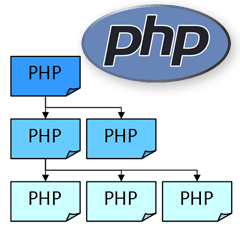 PHP developers have been demanding namespaces for some time. As PHP applications have grown larger and more complex, namespaces have become essential to prevent code clashes.
PHP developers have been demanding namespaces for some time. As PHP applications have grown larger and more complex, namespaces have become essential to prevent code clashes.
My recent tutorials received a number of comments complaining about namespace implementation in PHP. The main issues were the syntax and the backslash character. Before I tackle those issues, let’s take a quick look back at the history of PHP.
PHP is a Mess
Languages such as C# and Java were designed and follow rigorous syntax standards. PHP has evolved. The original version was released in 1995 and, by version 3, it was a popular procedural programming language. Version 4 introduced rudimentary object orientation and version 5 provides a reasonably standard OOP model. Namespaces have now been added to version 5.3.
PHP critics will argue that the language is a mess. Function names are inconsistent (e.g. strpos, str_split, substr), object handling has been tagged on, and some of the syntax is different — if not bizarre — when compared with other languages.
However, PHP remains the most widely-used server-side development language. Its versatility is one of its primary strengths:
- Novice developers can start with simple procedural programming. They need never touch OOP techniques and can still be productive.
- Code written 10 years ago in PHP 3 still works today in PHP 5.3. A few minor tweaks may be required, but major rewrites are rarely necessary.
PHP code may not always be pretty, logical, or elegant, but development is rapid and often easier to comprehend than the alternatives.
PHP Namespace Implementation
Unlike C# and Java, PHP has to retain compatibility with non-namespaced code. That has been achieved and you can choose whether to use namespaces or not. However, if you’re using PHP 5.3 (or above), I would recommend them — even if you simply use the same name throughout the whole of your project.
The choice of namespace and use as namespace operators seems logical. Some developers may disagree, but that would have been the case no matter what they’d been named. eTor
Finally, we come to the backslash character. Most critics complain that it’s ugly, difficult to read, and awkward to type on a Mac. However, I still consider it preferable to the double-colon that was originally proposed. Examine the following static method call:
// PHP 5.3 beta static method call
echo ::App::Lib1::MyClass::WhoAmI();
// PHP 5.3 final static method call
echo AppLib1MyClass::WhoAmI();
The second line is quicker to type, less error-prone, easier to read, and simpler to understand. If you see a backslash outside of a string, you know namespacing must be involved.
Of course, it would be great if PHP used a ‘.’ period for public methods, static methods, and namespaces. That would make it consistent with Java, C#, JavaScript, Python and many other languages. Unfortunately, PHP’s history and backwards compatibility makes that difficult to achieve.
No language is perfect, and PHP is far from it! However, namespacing has been implemented well, especially when you consider the restrictions and problems it could have caused. I’m sure you’ll learn to love that backslash!
Related reading:
- How to Use PHP Namespaces, Part 1: The Basics
- How to Use PHP Namespaces, Part 2: Importing, Aliases, and Name Resolution
- How to Use PHP Namespaces, Part 3: Keywords and Autoloading
Frequently Asked Questions about PHP Namespaces
What is the main purpose of using PHP namespaces?
PHP namespaces are primarily used to encapsulate items such as classes, functions, and constants to prevent naming collisions. They provide a way to group related classes, interfaces, functions, and constants together, which can be particularly useful in large programming projects. By using namespaces, developers can avoid conflicts between code from different libraries or modules, making the code more manageable and less prone to errors.
How do I declare a namespace in PHP?
Declaring a namespace in PHP is straightforward. At the beginning of your PHP file, you simply use the ‘namespace’ keyword followed by the name you want to give to the namespace. For example, namespace MyNamespace;. It’s important to note that the namespace declaration must be the first thing in your PHP file, before any other code or HTML.
Can I use multiple namespaces in a single PHP file?
Yes, you can use multiple namespaces in a single PHP file. This is done by using the ‘namespace’ keyword again to declare a new namespace. However, it’s important to note that any code, classes, functions, or constants declared before the new namespace declaration will belong to the previous namespace.
How do I access items in a namespace?
To access items in a namespace, you use the namespace name followed by a backslash and the item name. For example, if you have a function named ‘myFunction’ in a namespace named ‘MyNamespace’, you would access it like this: MyNamespace\myFunction();.
What is the difference between a defined namespace and a global namespace?
A defined namespace is one that you create using the ‘namespace’ keyword. It allows you to group related items together and avoid naming conflicts. On the other hand, the global namespace is the default namespace in PHP. If you don’t define a namespace, your code will automatically belong to the global namespace.
Can I import classes, functions, and constants from one namespace to another?
Yes, you can import classes, functions, and constants from one namespace to another using the ‘use’ keyword. This can be particularly useful if you want to use a class, function, or constant from a different namespace without having to use the full namespace path every time.
What is namespace aliasing in PHP?
Namespace aliasing in PHP allows you to refer to a namespace using a different name. This can be useful if the namespace has a long or complicated name. You can create an alias using the ‘use’ keyword followed by the namespace name and the ‘as’ keyword followed by the alias name.
Can I use namespaces with autoload in PHP?
Yes, you can use namespaces with autoload in PHP. Autoload is a feature in PHP that automatically loads classes when they are needed. By using namespaces with autoload, you can organize your classes in a way that makes sense for your project and avoid having to manually include each class file.
How do I handle exceptions in a namespace?
Handling exceptions in a namespace is similar to handling exceptions in the global namespace. You can use the ‘try’, ‘catch’, and ‘finally’ keywords to handle exceptions. However, if the exception class is defined in a namespace, you need to use the fully qualified name of the exception class or import the exception class using the ‘use’ keyword.
Can I use namespaces in PHP 5?
Yes, you can use namespaces in PHP 5. The namespace feature was introduced in PHP 5.3.0. However, it’s important to note that the syntax and features of namespaces have been improved in later versions of PHP, so it’s recommended to use the latest version of PHP if possible.
Craig is a freelance UK web consultant who built his first page for IE2.0 in 1995. Since that time he's been advocating standards, accessibility, and best-practice HTML5 techniques. He's created enterprise specifications, websites and online applications for companies and organisations including the UK Parliament, the European Parliament, the Department of Energy & Climate Change, Microsoft, and more. He's written more than 1,000 articles for SitePoint and you can find him @craigbuckler.
